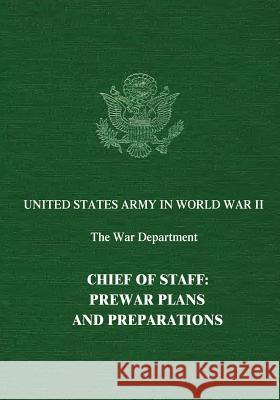Chief of Staff: Prewar Plans and Preparations » książka
Chief of Staff: Prewar Plans and Preparations
ISBN-13: 9781514870525 / Angielski / Miękka / 2015 / 576 str.
In publishing the series, UNITED STATES ARMY IN WORLD WAR II, the Department of the Army has four objectives. The first is to provide the Army itself with an accurate and timely account of its varied activities in mobilizing, organizing, and employing its forces for the conduct of war-an account that will be available to the service schools and to individual members of the Armed Services who wish to extend their professional reading. The second objective is to help enlarge the thoughtful civilian's concept of national security by describing the basic problems of war and the methods of meeting these problems. The third objective is to preserve for the record a well-merited tribute to the devotion and sacrifice of those who served. The fourth objective is to stimulate further research by providing students with a guide to the mountainous accumulation of records produced by the war. The decision to prepare a comprehensive account of military activities was made early in the war. Trained historians were assigned to the larger units of the Army and the War Department to initiate the work of research, analysis, and writing. The results of their work, supplemented by additional research in records not readily available during the war, are presented in this series. The general plan provides for subseries dealing with the War Department, the Army Air, Ground, and Service Forces, the technical services, and the theaters of operations. This division conforms to the organization of the Army during World War II and, though involving some overlapping in subject matter, has the advantage of presenting a systematic account of developments in each major field of responsibility as well as the points of view of the particular commands. The plan also includes volumes on such topics as statistics, order of battle, military training, the Women's Army Corps, and other subjects that transcend the limits of studies focused on an agency or command. The whole project is oriented toward an eventual summary and synthesis. No claim is made that it will constitute a final history. Many years will pass before the record of the war can be fully analyzed and appraised. This, the first volume on the Office of the Chief of Staff in World War II, highlights a significant and unprecedented preparation for war. It covers a period when longheaded military leadership and direction were needed before the people had been aroused to expression of their will, a people not yet aware of the dangers that lay ahead. More specifically, it tells of the contributions to national security that were made during the prewar period by the Chief of Staff and his immediate assistants. It is a history of military famine followed by plenty. It is a history of mistakes made as well as successes accomplished and of vision, foresight, forbearance, and selflessness. It is a history of deepening confidence, shared by the President, the Congress, and the people, in the integrity and ability of a leader who, although he did not aspire to greatness, was all the greater by reason thereof. During the period here depicted the Chief of Staff built so well and so strongly that the tragedy of Pearl Harbor did not shake the confidence of the nation. Mark Skinner Watson, the author of this volume, was an artillery officer in World War I, a war correspondent during the recent conflict, and a student of military affairs for many years. His dispatches to the Baltimore Sun won the Pulitzer Prize for International Correspondence in 1945.
Zawartość książki może nie spełniać oczekiwań – reklamacje nie obejmują treści, która mogła nie być redakcyjnie ani merytorycznie opracowana.











